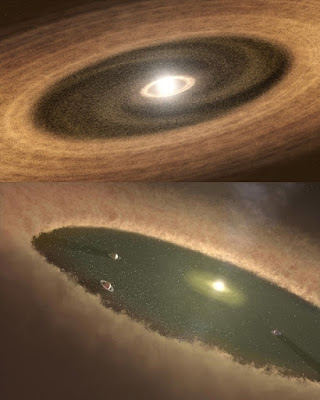“We
also expect that there are more systems like this one, and we would like to
find them”
Researcher and
Astronomer Josh Eisner from the Arizona team that discovered proto-planet
dubbed LkCa 15b
Scientists
have for the first time, observed something that's quite spectacular.
In
November 2015, it was announced that a team of researchers from the University
of Arizona led by astronomer Zhaohuan Zhu has discovered what may be the first
planet about to be born as reported in the article “A
Planet Is Born - And We Have The Pictures To Prove It”, published November
19 2015, by Brid-Aine Parnell, Forbes.
The
alien proto-planet, dubbed LkCa 15b, orbits a star LkCa 15 450 light years
away, was spotted back in 2011 using the Keck telescopes on Mauna Kea in
Hawai'i. Researchers suspected back then it was planet in formation, being as
it cut a huge swathe thought the star's disk 100 times wider than the distance
between the Earth and the sun.
Being
the first planet for the star LkCa 15 450, LkCa 15b is very close to its host
star and may gradually spiral inwards.
The
researchers, in their publication in the Journal Nature entitled “Astrophysics:
Growing planet” brought to light have also achieved a first; direct imaging
of the proto planet in the process of being formed as noted in the article “Scientists
witness the Developement of Baby planets for the first time”, published
November 18, 2015 By Sarah Fecht, Popular
Science.
So
how did they image proto-planet LkCa 15b?
University of Arizona
discovers proto-planet LkCa 15 450 – How burping H-alpha photons is signs of a
growth spurt
Like
any normal main sequence star, a planet's formation will give off tell tale
signs of radiation.
As
the ball of gas develops and swirls into a planet, it develops an accretion
disk of unused gas and dust around the main structures forming the planet. as
it swirls, its magnetic field suck in and heats up that nebulous accretion disk
gas to temperatures as high as 9704 C (17,500 F).
Heating
hydrogen gas in the accretion disk to this temperature gives off a specific
wavelength of light called H-alpha photons, which the researchers spotted using
the Large Binocular Telescope in Arizona.
Using
an H-alpha photo filter on the telescope, they spotted the signature radiation
coming from the accretion disk of this object, suggesting that this was indeed
a planet in formation along with possibly two (2) other sibling planets.
As
2016 rolls on, the researchers are looking to finds ways to study the chemistry
of the atmosphere of these proto-planets as they form, even though the process
may take millions of years.
This
as it may give insights into how life can possibly form, especial as one of the
planets may end up being a Jupiter-like body with exomoons that support life as
explained in my blog
article entitled “University
of Sao Paulo Astronomers find HIP 11915 with Jupiter-like exoplanet – Earth 2.0
beckons in the Jovian Moons”.
Possibly
this proto-planet LkCa 15b and its two other siblings are involved in a sibling
rivalry as they feed of their mother nebulous milk?
Here's
the article



No comments:
Post a Comment
Please register and leave you comments. For contact, leave an email or phone number and I'll be sure to get back to you.